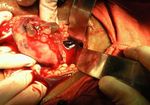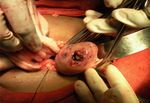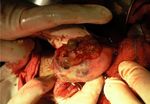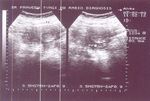Rare Presentation of Chorioadenoma Destruens as Acute Haemoperitoneum Mimicking Ruptured Ectopic Pregnancy
←
→
Page content transcription
If your browser does not render page correctly, please read the page content below
KATHMANDU UNIVERSITY MEDICAL JOURNAL
Rare Presentation of Chorioadenoma Destruens as Acute
Haemoperitoneum Mimicking Ruptured Ectopic Pregnancy
Sinha M,1 Kaur R,1 Gupta R,2 Rani R,1 Aggarwal A1
Department of Obstetrics & Gynaecology
1
Kasturba Hospital, Delhi, India
ABSTRACT
West Virginia University- Charleston Division
2
Gestational trophoblastic neoplasms (GTN) are proliferative degenerative disorders
Charleston Area Medical Center of placental elements and include complete or partial mole (90%), invasivemole
(5-8%), choriocarcinoma (1-2%) and placental site tumor (1-2%). Chorioadenoma
Charleston, West Virginia, USA
destruens is a trophoblastic tumor, characterized by myometrial invasion through
direct extension or via venous channels. We present a case of invasive mole eroding
uterus and uterine vasculature, causing sudden rupture of uterus with massive
Corresponding Author
haemoperitoneum mimicking ectopic pregnancy. A 20 year old G1P0 at 6 weeks
Ramandeep Kaur gestation presented in Casualty of Kasturba Hospital complaining of severe acute
onset lower abdominal pain for one hour. Clinical examination revealed shock.
Department of Obstetrics & Gynaecology
Sonography suggested ectopic pregnancy and immediate exploratory laparotomy
Kasturba Hospital, Delhi, India was decided. On laparotomy, 2000cc of haemoperitoneum was noted. Grape like
vesicles protruding through fundal perforation with profuse active bleeding was
E-mail: ramandeepkh@yahoo.in
seen. Bleeding persisted despite evacuation. Step wise uterine devascularisation
failed to achieve haemostasis. Total abdominal hysterectomy was performed as a
life saving measure.
Citation
Sinha M, Kaur R, Gupta R, Rani R, Aggarwal A. Rare
Presentation of Chorioadenoma Destruens as Acute KEY WORDS
Haemoperitoneum Mimicking Ruptured Ectopic
Pregnancy. Kathmandu Univ Med J 2014;48(4):288-91. Ectopic pregnancy, haemoperitonem, invasive mole
INTRODUCTION
Invasive mole or chorioadenoma destruens comprises 15 chorioadenoma destruens may present rarely as ruptured
% of all gestational trophoblastic neoplasia (GTN).1 GTN ectopic pregnancy in shock, incomplete abortion,
is characterized by histological abnormalities of chorionic menorraghia or carcinoma endometrium.6,7
villi with oedema of villous stroma and varying degrees of
We present a case of invasive mole which gradually eroded
trophoblastic proliferation. Absence or presence of fetal or
in the uterus and the uterine vasculature, leading to
embryonic elements classifies complete or partial mole.
sudden rupture of uterus, massive hemoperitoneum and
Molar pregnancies which fail to regress result in invasive
shock, mimicking ectopic pregnancy.
mole, choriocarcinoma, persistent trophoblastic tumor or
placental site trophoblastic tumor.2
Molar pregnancies become Invasive moles in 20% CASE REPORT
and are commoner in complete molar pregnancies.3,4 A 20 year old G1P0 at 6 weeks gestational age presented
Chorioadenoma destruens is a trophoblastic tumor, to the emergency room of Kasturba Hospital complaining
characterized by myometrial invasion through direct of severe lower abdominal pain, acute in onset and for the
extension or via venous channels with persistence of past one hour. Her pain was severe, colicky in nature and
edematous chorionic villi and trophoblastic proliferation radiated to the back and thighs. She denied any nausea,
invading myometrium.5 The presence of villi in the vomiting or fever. Her past medical and surgical histories
trophoblastic tissue differentiates an invasive mole were unremarkable. She denied any known drug allergies
from choriocarcinoma Instead of vaginal bleeding (97%) and was not on any medications. She attained menarche at
Page 288Case Note VOL. 12 | NO. 4 | ISSUE 48 | OCT- DEC 2014
Figure 1. Ultra Sonography prior to surgery Figure 2. Uterine fundal perforation showing Figure 3. Uterine fundal perforation
grape like vesicles protruding through the showing grape like vesicles protruding
perforation through the perforation& profuse bleeding
Figure 4. During hysterectomy- uterus showing Figure 5. Cut section of the uterus following hysterectomy
large perforation showing chorioadenoma destruens with tissue & Blood clot
the age of 12 years and her menstrual cycles were regular. On, exploratory laparotomy, 2000cc of hemoperitoneum
She denied any pregnancies in the past and had a marriage was noted, with peritoneal cavity full of blood and clots.
history of one year. Uterus was perforated at the fundus and profuse active
bleeding was noted at the site of perforation. Grape like
On examination patient was awake, alert and oriented but
vesicles were protruding through the uterine perforation
was in apparent distress. She was hypotensive with BP of
which measure approximately 3 cm x 3 cm (Fig 2, Fig 3). The
90/60 mm of Hg, tachycardic with pulse of 112 b/min. She
uterus was eight weeks in size, soft and enlarged, bilateral
was pale clinically, afebrile and her respiratory rate was
adenxae were normal. On further abdominal exploration,
16/min. Her cardiac, respiratory and neurological system
no ectopic tissue or metastatic tissue was identified.
evaluation was unremarkable
Profuse ongoing bleeding was seen from site of perforation
On abdominal examination, she was severely tender in
following complete evacuation of the uterus and patient
bilateral lower quadrants, with presence of guarding,
continued to remain in a state of shock despite adequate
rigidity and rebound tenderness. On bimanual examination,
fluid replacement, 4 units of blood transfusion and 20 units
cervical os was closed, the uterine size could not be assessed
of continuous oxytocin infusion. To achieve haemostasis,
due to presence of guarding and tenderness. These
step wise systematic uterine devascularization was
findings were highly suggestive of ectopic pregnancy and
attempted but complete haemostasis could be not be
emergency transvaginal ultrasound (TVS) was performed,
achieved and patient continued to bleed profusely from
which demonstrated anteverted uterus, measuring
the perforated site. Decision was made to proceed with
approximately – 46 x 60 x 76 mm with irregular echogenic
total abdominal hysterectomy as a life saving measure.
products seen in uterine cavity. Pouch of Douglas showed
Post surgery patient became haemodynamically stable.
moderate amount of free fluid. However, a definitive
Hysterectomized uterus was then sent for histopathological
diagnosis of ectopic pregnancy could not be established.
examination (Fig 4, Fig 5).
During TVS, patient became drowsy and slipped into a semi
Her postoperative course was uncomplicated.
comatose condition. Her vitals deteriorated with pulse
of 140/min and systolic blood pressure of 60 mm of Hg. On postoperative day one, her vitals improved and her
Patient was immediately rushed to operation theatre for hemoglobin was 8 gm/dl. She received additional two units
Emergency laparotomy with a definitive suspicion of a of blood transfusion and made an uneventful recovery.
ruptured ectopic pregnancy. On laboratory investigation,
The postoperative metastatic work-up included
her haemoglobin and hematocrit was 6 gram and 20 mg
serum biochemistry, chest x-ray and upper abdominal
percent, random blood sugar values of 130 mg/dl, Serum
Ultrasonography and no evidence of metastasis was
Bilirubin 1.2 mg/dl, and Serum creatinine 0.9 mg/dl. Her
detected. In view of low levels of serum ß-hCG, patient
beta HCG could not be sent as emergency laboratory
was kept under surveillance with serial quantitative ß-hCG
facilities of Kasturba Hospital does not include this
estimation to consider chemotherapy if ß-hCG levels
investigation.
Page 289KATHMANDU UNIVERSITY MEDICAL JOURNAL Figure 6. Section from uterus showing a Figure 7. The tumour cells are showing Figure 8. Syncytiotrophoblasts and tumour arising from endometrial surface and vascular invasion. (H&E, X 20) intermediate trophoblasts are infiltrating composed of intermediate trophoblasts and the myometrium as single cell infiltrate. afew multinucleated syncytiotrophoblasts, (H&E, X 20) arranged in sheets. (H&E, X40) remains at a plateau or rises. Postoperatively ß-hCG level of gestational trophoblastic neoplasia with uterine rupture was 110 mIU/ml. Patient was discharged home in stable are often catastrophic owing to profuse bleeding, which condition on postoperative day 3. Her ß-hCG level was could potentially be lethal.
Case Note VOL. 12 | NO. 4 | ISSUE 48 | OCT- DEC 2014
is either unavailable or not affordable and chances of losing Use of chemotherapy in the management of invasive mole is
the woman to follow-up are high. The recommendations still debatable, with the evidence of spontaneous regression
for post-molar follow-up include serum βhCG levels every of metastatic mole in the literature. Chemoprophylaxis may
1–2 weeks after evacuation until normal, hCG levels 2–4 be particularly useful in patients with a high-risk complete
weeks after the first normal level, and hCG surveillance mole when hormonal follow-up is either unavailable or not
every 1–2 months for 6 months after the first normal hCG affordable and chances of losing the woman to follow-up
level. Serial hCG monitoring of women with disease in are high. We did not consider chemotherapy in our case in
prolonged remission (greater than 1 year) often provides view of no evidence of metastasis and low ß-HCG levels on
early evidence of recurrence, though GTT may rarely be subsequent follow up. The potential risk of patient being
associated with undetectable levels of hCG.8 lost to follow up was very much there but did not happen
in our case.
In our patient, we were unable to achieve adequate
haemostasis by step wise uterine devasculaization
attempted with uterine and ovarian vessel ligation. CONCLUSION
Unfortunately the surgical emergency team was not well
versed with the technique of Internal Iliac Ligation, hence it Chorioadenoma destruen has a potential for myometrial
was not attempted and total abdominal hysterectomy was and vascular invasion, leading to uterine perforation
and massive hemorrhage. Therefore, to avoid adverse
then performed. Although the development of effective
consequences it is necessary to identify such cases by early
chemotherapy has resulted in improved survival of patients first trimester ultrasound. Continued reporting of these
with gestational trophoblastic tumor, hysterectomy cases are important so that the obstetricians are aware
remains an important adjuncts in the treatment of a about the possibility of ruptured invasive mole and it should
selected subset of patients. be kept as a differential diagnosis in all the young pregnant
women presents with acute onset lower abdominal pain.
REFERENCES
1. Kumar S, Vimla N, Mittal S. Invasive mole presenting as acute 8. Miller FM, Laing FC. Gestational trophoblatic disease http://
hemoperitoneum. J K science. 2004;6: 159-160. brighamrad. havard.edu/cases/bwh/hcache/34/full.html
2. Berkowitz RS, Goldstein DP, In: Berck JS. Gestational trophoblastic 9. Mackenzie F, Mathers A, Kennedy, J Invasive hydatidiform mole
neoplasm. PhiladelphiaLipincott, Williams and Wilkins, 2002.1353- presenting as an acute primary haemoperitoneum. Br J Obstet
74. Gynecol. 1993; 100: 953-54.
3. D. Berek & Novak’s Gynecology, 14th ed, Philadelphia, Lippincott 10. Wilson RB, Hunter IS, Dockerty MB. Chorioadenoma Destruens. Am J
Williams & Wilkins, 2007. p1581-1604. Obstet Gynecol. 1961; 81: 546-59.
4. Kittur S, Venktesh, Ramlingappa A. A rare case of invasive mole with 11. Hol K, Junnare K, Shekhawat GS, Damle H. Case of Invasive Mole with
silent uterine perforation. Int J. Reprod Contracept Obstet Gynecol Uterine Rupture Presenting as a Hemoperitoneum. Global Research
2013;2:109-10. Analysis, 2013 Dec; 2(12): 195-96.
5. Atala C, Riedemann R, Biotti M, Ramírez F, Paublo M. Invasive mole 12. Branka N, Jelena L. Invasive mole case report of massive uterine
with uterine rupture. Rev Chil Obstet Ginecol. 1992;57(5):356-8. destruction- Med Arh. 2008;62:242–243.
6. Singh A and, Ratnani RJ. Heterogenous presentation of Chorioadenoma 13. Mitani Y, Jimi S, Takao N. Partial resection of the uterus for
destruens. J Obstet Gynaecol India. Dec 2012; 62(Suppl 1): 71–74. chorioadenoma destruens. J Jpn Obstet Gynecol Soc. 1968
Jul;15(3):163-7.
7. Mandal D, Nandi N, Dey RP, Biswas RR, Bhattacharya AK, Biswas SC.
Partial Invasive Molar Pregnancy – Two Case Reports. Al Ameen J Med 14. Goldstein DP and Berkowitz RS. Gestational Trophoblastic Neoplasia.
Sci. 2010; 3(1): 91-93 WB Saunders, Philadelphia; 1982. 98-121.
Page 291You can also read

























































